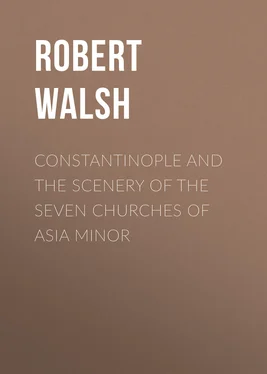Robert Walsh - Constantinople and the Scenery of the Seven Churches of Asia Minor
Здесь есть возможность читать онлайн «Robert Walsh - Constantinople and the Scenery of the Seven Churches of Asia Minor» — ознакомительный отрывок электронной книги совершенно бесплатно, а после прочтения отрывка купить полную версию. В некоторых случаях можно слушать аудио, скачать через торрент в формате fb2 и присутствует краткое содержание. Жанр: foreign_prose, foreign_home, История, foreign_antique, на английском языке. Описание произведения, (предисловие) а так же отзывы посетителей доступны на портале библиотеки ЛибКат.
- Название:Constantinople and the Scenery of the Seven Churches of Asia Minor
- Автор:
- Жанр:
- Год:неизвестен
- ISBN:нет данных
- Рейтинг книги:5 / 5. Голосов: 1
-
Избранное:Добавить в избранное
- Отзывы:
-
Ваша оценка:
- 100
- 1
- 2
- 3
- 4
- 5
Constantinople and the Scenery of the Seven Churches of Asia Minor: краткое содержание, описание и аннотация
Предлагаем к чтению аннотацию, описание, краткое содержание или предисловие (зависит от того, что написал сам автор книги «Constantinople and the Scenery of the Seven Churches of Asia Minor»). Если вы не нашли необходимую информацию о книге — напишите в комментариях, мы постараемся отыскать её.
Constantinople and the Scenery of the Seven Churches of Asia Minor — читать онлайн ознакомительный отрывок
Ниже представлен текст книги, разбитый по страницам. Система сохранения места последней прочитанной страницы, позволяет с удобством читать онлайн бесплатно книгу «Constantinople and the Scenery of the Seven Churches of Asia Minor», без необходимости каждый раз заново искать на чём Вы остановились. Поставьте закладку, и сможете в любой момент перейти на страницу, на которой закончили чтение.
Интервал:
Закладка:
The reign of Mustapha II. was marked by calamities which have never since ceased to afflict the Turkish empire. Besides the ordinary inflictions of war, every other seems to have been laid, by the hand of Providence, on this ruthless nation: Constantinople and Pera were utterly destroyed by fire−a bolt of thunder fell on the imperial mosque, and left it in ruins−the caravan of pilgrims proceeding to Mecca was attacked by Arabs, and 25,000 of them put to the sword−the turbulent Janissaries, availing themselves of every pretext for discontent, were again in a state of insurrection, and compelled the sultan to fly for his life to Adrianople, along with the mufti. Here he was obliged to surrender the unfortunate head of the church, who was treated with every indignity, and then thrown into the river, where he perished. The new mufti, with his son, were seized, tortured, and executed; and the sultan himself was soon after deposed in 1703, and his brother Achmet set on his throne. This military revolt was the most serious that had afflicted the empire since its foundation, and was a prominent feature of that principle of total disorganization, which seemed inherent in the political and moral state of this people.
Achmet III. was called to succeed his brother, and his first act was to avenge himself on the conspirators, who had placed him on the throne in a truly Turkish manner. He disarmed their suspicions by rewards and promises, and, having separated them into various situations of trust and profit, caused every man of them to be strangled in detail.
Notwithstanding the state of insecurity of every thing in Turkey, it nevertheless became in his reign the asylum of the Christian monarchs of Europe. Charles XII. of Sweden, and Stanislaus the king of Poland, whom he had set up, both fled thither for protection: yet, violent and outrageous as was the conduct of “Macedonia’s madman,” whom the Turks for folly and obstinacy called “Ironhead,” both kings were treated with kindness and hospitality. They were followed by their great enemy, the czar Peter, whose usual sagacity seemed to have deserted him. He was shut up behind the Pruth by the Turks, and they had now the opportunity of holding three Christian monarchs in their hands, and dictating what terms they pleased: but avarice, that ruling passion of the Osmanli, saved Peter and his army−Catherine, his wife, who had accompanied him, brought in the night all her personal jewels, and as much money as she could collect, to the czar, who immediately sent them to the grand vizir: he was not able to resist the offer, and the Russian monarch and his army were allowed to depart in peace.
Another circumstance distinguished the reign of Achmet III., even still more important than his being the arbiter of the fate of three Christian kings. The art of printing had now been invented for more than two hundred and fifty years, and every other state in Europe had adopted the important discovery. The Turks alone rejected it, and assigned, as a reason, that it was an impious innovation. They allowed no book but the Koran; they affirmed that it contained every thing necessary for man to know, and any other knowledge was worse than useless. Such was their veneration for this book, that it was strictly forbidden to sit, or lay any weight, upon a copy of it; and if a Frank was detected in the act of doing so, even unwittingly and by accident, he was immediately put to death. This veneration they extend to paper of any kind, because it is the material of which the sacred book is composed, and that on which the name of Allah is written; and hence they strictly prohibit its being desecrated by any common use, and carefully lay up any fragment of it which they accidentally find. The process of printing they consider as compressing and defiling a sacred book, and the mufti denounced it. It was not, then, till the year 1727, that this innovation was tolerated, and a press established at Constantinople. Even then it was done in such a way as was attended with no advantage to an ignorant people. It was still prohibited to print the Koran, and, as that was almost the only book read in the empire, little was added to Turkish knowledge. Achmet was soon after deposed, and the patron of printing deemed unfit to reign.
He was succeeded in 1730 by his nephew Mahomet, the fifth of the name who had ascended the throne of Turkey, but usually called Mahmoud I. It was in his reign the celebrated usurper, Thamas Kouli Khan, seized on the crown of Persia, and war was kindled with the Turks. These nations comprise the two great sects into which the followers of the Prophet are divided. The Persians hold in abhorrence Abubekir and Omar, whom the Turks revere; and they adhere to the doctrines of Ali, whom the Turks abhor. The latter call themselves Sunni , or “the orthodox,” and have no fellowship or communion with the Rafazir or Shiites , “infidels” or “heretics.” They affirm, that Allah may have mercy on Jews and Christians, but he will have none on the Persians, whom he hates sixty and ten times as much as the most inveterate infidels. The enmity, therefore, between the discordant sects of the faithful is even greater than between the faithful and the infidel. It was the enlightened policy of Thamas Kouli Khan to put an end to this bloody dissention, and reconcile the different shades of opinion among the professors of the same religion. It was stipulated as an article in the peace which followed, that their respective priests should labour assiduously to this end; but, like all such attempts, it was unavailing, and the enmity is at this day more inveterate than ever. Mahmoud died in 1754, and was regretted as the least sanguinary of the Ottoman race.
But the time was now approaching when the dynasty of the Mohammedans in Europe seemed hastening to its close. The Russians, ever since the capture of Asoph, on the Mœotis, by Peter the Great, had never ceased advancing on Constantinople. The Turkish territories on the north of the Euxine were intersected by vast rivers which fell into that sea; and the policy of the Russians was, to advance from river to river, and, at the end of every war, to make the last the boundary of their territory, and secure for themselves all that lay behind it. In this way Catherine pushed her frontier to the Dnieper, and built a naval arsenal at Cherson, thereby establishing a naval supremacy on the Black Sea; and, that her object might not be ambiguous, she caused to be inscribed on the western gate, “This is the road to Constantinople.” Meantime, the Turkish government seemed to contain within itself the elements of rapid decay. While all Europe was advancing in the arts and sciences which improve life and strengthen kingdoms, the Turks alone stood still and refused to move−their ignorance inveterate, their obstinacy intractable, their cities falling to ruins, their population daily decreasing, their internal dissensions growing more sanguinary, and, above all, the insolence of the Janissaries without control−interdicting every improvement, paralyzing every effort, utterly inefficient as soldiers, and formidable only to their own government. The first step, therefore, was to establish some force to restrain these men, that the people might be at liberty to follow other states in the march of amelioration: and this was now undertaken by the reigning sovereign.
Selim III. was the most amiable and enlightened man that had yet filled the throne of the Osmanli. He succeeded his uncle, Abdal Hamed Khan, whose sons were infants at the time of their father’s death in 1789. His anxious wish was to correct the prejudices, and enlighten the ignorance of his subjects, by gradually introducing European usages among them. His first improvements were military: a corps was formed, adopting the European discipline, and called the nizam dgeddit , or “new regulation.” Against this innovation the Janissaries revolted: they spurned with indignation all customs but their own; they thought their institutions the perfection of human nature, and that any change must be a degradation. They therefore deposed Selim in 1807, and called to the throne his cousin, Mustapha IV., the son of Abdul Hamed Khan, who had now arrived at adult years. Selim, however, by his many good and amiable qualities, had secured the affections of a large body of his subjects, who, though they did not accede to his military plans, were strongly attached to his person: and among these was Mustapha Bairactar.
Читать дальшеИнтервал:
Закладка:
Похожие книги на «Constantinople and the Scenery of the Seven Churches of Asia Minor»
Представляем Вашему вниманию похожие книги на «Constantinople and the Scenery of the Seven Churches of Asia Minor» списком для выбора. Мы отобрали схожую по названию и смыслу литературу в надежде предоставить читателям больше вариантов отыскать новые, интересные, ещё непрочитанные произведения.
Обсуждение, отзывы о книге «Constantinople and the Scenery of the Seven Churches of Asia Minor» и просто собственные мнения читателей. Оставьте ваши комментарии, напишите, что Вы думаете о произведении, его смысле или главных героях. Укажите что конкретно понравилось, а что нет, и почему Вы так считаете.












